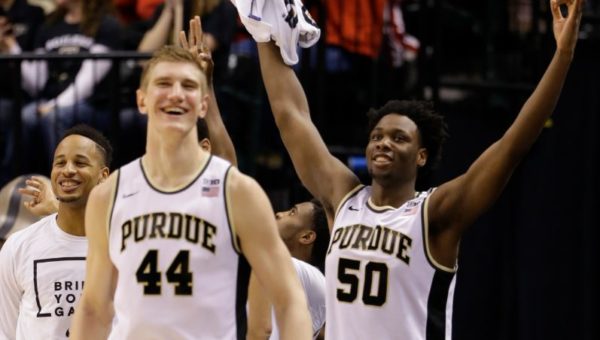Should Purdue Think About Going Small?
Posted by Jim Root on December 28th, 2016Entering the season, West Lafayette, Indiana, had a fairly legitimate claim to possession of the best collegiate frontcourt in college basketball (apologies to Wisconsin and a couple of other teams). Between incredibly versatile swingman Vince Edwards, half-man/half-Terminator center Isaac Haas, and former five-star power forward and Big Ten POY candidate Caleb Swanigan, the Boilermakers had the bodies to own the paint in most any match-up.

Vince Edwards, Isaac Haas and Caleb Swanigan provide a potent trio up front for the Boilermakers .(Associated Press)
Despite all of that front line talent, though, head coach Matt Painter has faced an interesting decision in how to deploy his best three players. Playing them at the 3-4-5 spots gives the Boilermakers a massive size advantage, but there are drawbacks with that lineup too. Haas, for example, can be a liability on both ends of the floor when pulled outside of the paint, and his presence on the offensive end — despite being a major weapon in drawing fouls and double-teams — can clog up the lane for the more dynamic Swanigan. To his credit, Swanigan has developed his outside shot to the point of greater respectability (52 percent from three-point range this season, compared with 29 percent last year), which resolves some of the prior spacing issues. But Painter’s tradeoff of playing Swanigan with Haas usually takes him out of the interior, where his combination of strength and quickness make him a match-up nightmare for most defenders.
Even more glaring, however, may be the defensive issues it causes. Both Haas and Swanigan struggle mightily in guarding the screener in the pick-and-roll, and Notre Dame responded to this weakness by repeatedly running that set against them. Because of this deficiency, Purdue must rely on precise rotations to adequately defend ball screens, and if Swanigan and Haas are both on the floor, Painter is left with two relative plodders attempting to make all the right defensive moves. Against teams with strong spacing and ball movement like Villanova and Notre Dame, the pair has struggled. In Purdue’s second half comeback against the Irish, Painter went small with Edwards and Swanigan at the four and five, respectively, and as a result, the Irish’s output was cut from 52 points in the first half to a paltry 29 in the second. This newfound defensive versatility allowed Purdue to seal off previously-open driving lines and kick-out opportunities.
Another factor impacting lineup decisions relates to how dangerous the Boilermakers’ shooters have been this year. With Swanigan serving as an offensive fulcrum in the paint, Painter can surround him with Edwards (47% 3FG) and three other shooters, rendering the Purdue offense nearly impossible to defend. While a bit turnover prone (sometimes due to the spacing issues while sharing the court with Haas), Swanigan is a willing passer out of double-teams, posting an-impressive-for-a-big-man 18.6 percent assist rate. That attribute, along with his nationally-elite rebounding and finishing, places him a robust third in Pomeroy’s Player of the Year race, and the team’s ninth-best three-point shooting rate nationally (41.3%) should continue to give him plenty of space to score and dish.
Purdue’s issue of playing two plodding bigs won’t be a problem against every opponent –- few teams possess the ball screen potency that Notre Dame and Villanova do, with multiple ball-handlers and shooters everywhere –- but having the small-ball weapon in the toolbox should prove invaluable for Painter’s crew. Overall, Purdue feels more potent on both ends of the floor while playing only one big man, but I’m just a guy with a computer, not a Big Ten head coach. How often Painter chooses to use it may ultimately decide how dangerous the Boilermakers end up being this season.









































